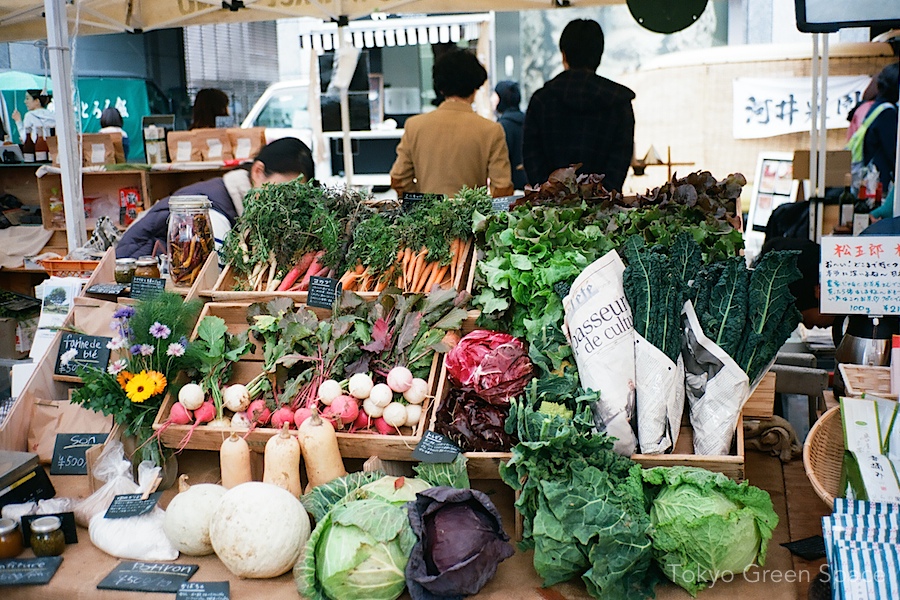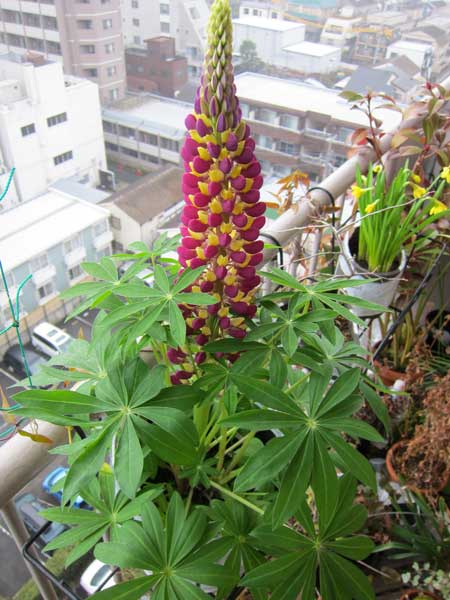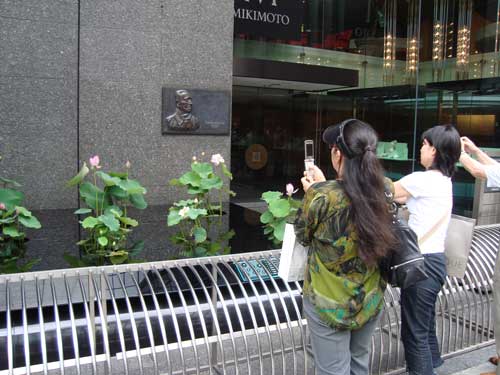
ファーマーズマーケットに、晩秋の野菜のディスプレイは素敵です。

開店ときに、歩道に花を見せる習慣は素敵だと思います。有名なイギリスのブーツ・ブランドの開店祝いに、きれいなピンクと赤い花のブーツを飾っていました。
Store, bar, and even ramen shop openings often feature sidewalk flower displays. I love the inventiveness of this special pink and red boot for the Dr Marten store opening in Aoyama.

.@jessmantellと@a_small_labと「動物建築」の打ち合わせの後で、有楽町駅でタヌキの集まりを発見して、楽しかったです。日常の風景を変えられる自由が、東京の働くひとにも住民にもあります。
After an “animal architecture” work meeting with @jessmantell and @a_small_lab, it was a fun surprise to see this gathering of tanukis and their frog and turtle friends in the Yurakucho station.
It’s not uncommon to spot plants and flowers in the Tokyo train and subway stations that appear to be the work of staff seeking to cheer up their environment, even their bath rooms.
I like seeing how Tokyo workers, along with residents, have such freedom to decorate and improve their everyday landscapes.

駅の新しい改札口がオープンしたときに、大きい花のディスプレイを送るのは、たぶん日本だけだと思います。JR中野駅北口のために、桜祭り協会もサンモールの協会も花を送りました。中野駅、おめでとう。
I love how there are huge flower displays celebrating the opening of the remodeled Nakano JR north exit. It’s a commercial tradition, extending to the opening of ramen shops and bars, too. These huge flower displays are from the Sun Plaza merchants association and the Nakano sakura festival organizers. I hope the redesigned plaza opens soon with a lot of new trees and plants!


この手袋はオーナを見つけたでしょうか。歩道のもう一つの使い方です。他の国では、落とし物こんな風に見せる習慣はあまり見られません。
It’s quite common to see that lost items are placed prominently at eye level, in case neighbors return to look for something that fell off a bike, stroller, or handbag. I’ve benefited myself from this system of retrieval and display. It’s a little late for gloves this year, but I hope they find their guardian.

この冬は長くて寒いですね。最近、自転車でホーム・センターに行って、花をたくさん買いました。ルピナスと言う花はキャンディーのような色です。北米の起原だけど、日本のは全然違います。ベランダに置きました。素敵です。
This winter seems to never end. So I biked over to the local home center recently, and loaded up on bright flowers including daffodils, tulips, stock, and this amazing lupinus. I am familiar with it as a very handsome deep blue flowering perennial, native to North America, that becomes a bush. I’d never seen it in candy colors and bred for maximum floral display. It’s at once familiar, odd, and just the right antidote for more cold days.

In my apartment building’s enormous recycling and garbage area, I found this lovely image of Mount Fuji staring at me. Only in Japan do residents neatly fold and lovingly display used items destined for shredding and recycling. This image is not of the artistic quality of Hiroshige (広重)’s 36 Views of Mount Fuji, it’s a lovely reminder of nature in an unlikely place.

渋谷駅で、菜の花のディスプレーが伊豆への電車旅行を宣伝しています。
I was delighted to see these nanohana (菜の花, or rapeseed) flowers in a subway display promoting rail trips to Izu, a subtropical peninsula a few hours from Tokyo. Rapeseed can be eaten like brocoli, used to make canola oil, or planted as a winter cover crop to improve soil quality. It is clever to promote rail trips to the countryside by bringing a bit of nature into the subterranean tunnels of heavily trafficked Shibuya station.

Thanks to Chris Palmieri of AQ design studio, here are two photos of a weekly flower display at Kiba Station, on Tokyo Metro’s Tozai line (T-13). The flower arrangement is created by a flower shop called Kawashima (フラワーショップ・カワシマ) in what seems to be an informal public-private partnership.
I like how the local flower shop is offering this public improvement and receiving some publicity for their work. It’s also incredibly lovely that they provide the names of the flowers they use with a simple hand drawing. My only question is why they are unable to make a slight improvement to the scuffed stand.
In the US or Europe, I imagine the entire arrangement, including the vase, would be quickly stolen. In Japan, there is much more opportunity to share individual and small business gardening with strangers.


I love how this collection of bonsais sits on recycled containers (air conditioning covers?) extending from the sidewalk into the street. The ability to share valuable and mobile plants in Tokyo public spaces continues to impress me. I also love the recycling, and the ingenuity of using the inside of the platform for storage. This collection sits across the street from the Tokyo University Botanic Garden in Bunkyo, and next door to the convenience store that handles the ticket sales.


I have had the pleasure of visiting Sinajina three times in the past three weeks: to talk with Kobayashi sensei about a project with the Portland Japanese Garden, to take a class with TEDxSeeds organizers, and to visit with my Newsweek Japan editor. In every visit, the store is set up differently, and the most seasonal bonsai are most prominently displayed.
Last weekend, the rose and mountain hydrangea perfectly capture the turning of the season from late spring to early summer. These bonsai are perfect in shape, buds just opening, and contrast with pot, gravel, and moss.
I also like the contrast between these plants and the hollyhocks I featured yesterday. All of them are seasonal flowers, yet they differ in scale and degree of human care. I like to think that urban nature extends from the wild and unruly to the groomed and domesticated.

Mikimoto in Ginza often has season flower displays that attract crowds of camera phone fans. This month it is lotus. I am always amazed at how Tokyoites are so enraptured at flower displays, displaying a hunger and appreciation for natural beauty in the city.

Dokudami (どくだみ) is one of my favorite Tokyo weeds. It grows on cinder block walls and sidewalk cracks. Above is a large patch in front of my apartment building in May. The roughly 2 by 5 meter strip is a never changing display of flowers tended by the residents; its wildness contrasts with the clipped hedge on the other side of the entry path and heavily pruned trees in the parking lot.
Here are some other May flowers, including what is called in Japan “American jasmine.” The middle two plants I do not know the names. The last one is Datura, originally from Mexico.
